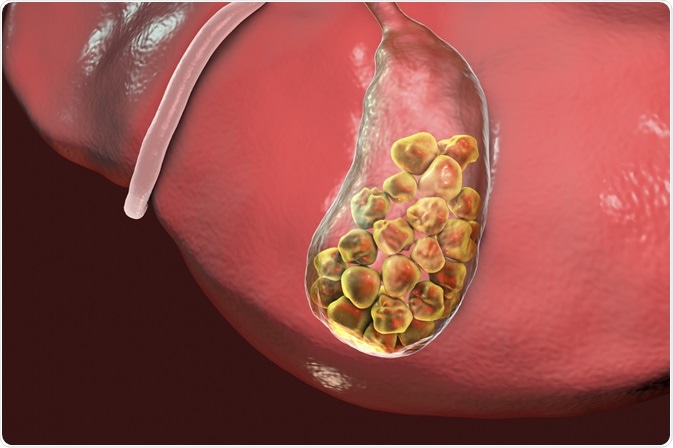Gallstones are small stones that form in the gallbladder or bile duct. The gallbladder is a small, pouch-like structure that lies in the upper abdomen and is connected to the liver and bowel by the bile duct. The bile duct is also connected to the pancreas. The gallbladder stores bile that the liver produces, which it then releases while a person is eating, to help breakdown fats and other substances in food.
Gallstones develop when substances present in the bile start to harden. Over many years, this may lead to several small stones forming or one large stone. A large stone can block the bile duct or travel along it and then obstruct the opening to the pancreas.
There are two main types of gallstones, which are cholesterol gallstones and pigment gallstones. Cholesterol gallstones are the most common type and occur when the diet is too rich in cholesterol. Pigment gallstones form when the bile is too rich in bilirubin, a breakdown product formed when red blood cells are broken down. These pigment stones are less common and develop in cases of blood disorders such as sickle cell anemia.
 Illustration of bottom view of liver and gallbladder with stones. Image Credit: Kateryna Kon / Shutterstock.com
Illustration of bottom view of liver and gallbladder with stones. Image Credit: Kateryna Kon / Shutterstock.com
Gallstone symptoms
Gallstones are very common and do not usually cause symptoms or complications. Most people who have them are aware of their presence. Almost one-quarter of women and a smaller number of men will have developed a gallstone by the time they are aged 60 years.
However, if the gallstone starts to move out of the gallbladder and becomes stuck in the bile duct, then various symptoms may manifest.
Common symptoms of gallstones include:
- Severe upper abdominal pain on the right side that may radiate across the back and shoulder blade
- Feeling sick or vomiting
- A high temperature, shivering and sweating
These symptoms are not always caused by gallstones but if you have them, see your GP.
Pain
Gallbladder stones that are not associated with complications such as cholangitis and pancreatitis are referred to as uncomplicated gallstones. The most common symptom of an uncomplicated gallstone is sudden and severe pain in the abdomen. The pain lasts anything from a few minutes to five hours and is not alleviated by vomiting or passing wind. The pain is caused by the gallbladder contracting to try and shift the stone. The pain occurs infrequently and can sometimes be relieved by walking around.
The pain may be felt in the middle of the abdomen, in-between the belly button and breast bone or it may be felt on the right-hand side radiating from just below the ribs, across the side and into the shoulder blade. This pain is referred to as biliary colic. The pain may worsen when a person eats fatty foods. The pain felt in cases of biliary colic is sometimes assumed to be caused by a peptic ulcer or a heart attack.
Gallstones | Clinical Presentation
Symptoms of complicated gallstone disease are described below:
- Pain that lasts longer than a few hours
- A fever (temperature higher than 38˚C)
- Increased heart rate
- Jaundice (yellowing of the skin and whites of eyes)
- Itchy skin
- Diarrhea
- Loss of appetite
- Confusion
- Chills
People should seek immediate medical attention if they develop intensive abdominal pain, jaundice or a temperature and chills.
Although gallstones can lead to a number of symptoms, they are also discovered incidentally when a patient is having an ultrasound scan or X-ray for an unrelated reason. Many experts believe that a lot of people develop gallstones at some stage during their life, but they are never aware of the fact.
The main test used to diagnose gallstones is transabdominal ultrasonography. Other tests that may be used include magnetic resonance chollangio-pancreatography, endoscopic ultrasonography and oral cholecystogram, duodenal drainage and intravenous cholangiogram.
The treatment approach to gallstones is usually observation followed by removal of the gall bladder, a process referred to as cholecystectomy. Less often, some other treatments that may be used include gallstone extraction, extra-corporeal shock-wave lithotripsy and dissolution with medication.
References
Further Reading